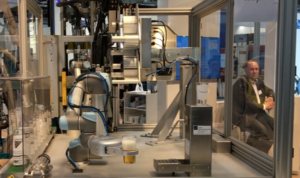Video: Massive growth in collaborative robots market could strengthen Universal
The market for collaborative robots is growing at a phenomenal rate, with some estimates suggesting it will go from $150 million a year now to more than $3 billion in five years.
The market leader in the cobots sector is currently Universal Robots, and this video is an interview with Helmut Schmid, the company’s general manager, with responsibility for a number of countries in Europe.
RoboticsAndAutomationNews.com spoke to Schmid at this year’s Hannover Messe, held in Germany recently.

Schmid suggests that while there is an increasing number of companies launching collaborative robots, the overall market growth may be enough for all of them to do well.
“The market for collaborative robots seems to be exploding,” says Schmid. “From $150 million to $3.3 billion is so huge that we – of course – want to keep our market share but for the rest there’s enough space left.”
Universal has sold more than 10,000 robots, according to research by RoboticsAndAutomationNews.com. This places it in about 14th position overall in the industrial robots market overall.
The majority of the companies on the list mainly manufacture and sell what could be called “traditional” industrial robots, which tend to be caged off because they are high-speed, high-payload machines and not designed to work close by humans.
Collaborative robots currently represent probably less than 10 per cent of the overall robots market, but it is a segment that has been growing.
It’s unlikely, however, that collaborative robots will replace traditional robots because cobots tend to be lightweight and are designed for lower payloads.
Rather, collaborative robots are likely to expand the total market for robots, partly because they appeal to a wider customer base than the traditional big buyers, such as automotive and industrial companies.
As Schmid says: “We believe the biggest growth will come from the certain segments of companies.
“Meaning, we think robots will work down from large companies – such as Volkswagen, BMW and Siemens – down to the small and medium-sized companies, and there are millions of them, and most of them are not automated yet.
“We believe small and medium-sized companies are open about using collaborative robots because they are easy, cheap and have a very fast return on investment. This will be the biggest growth area.”
Schmid adds that one of the main reasons which will encourage wider adoption of the Universal collaborative robot, in particular, is that “these kind of robots are very easy to programme, so you do not need to be a specialist”.
Most users could get one running after 30 minutes’ training, he says.

